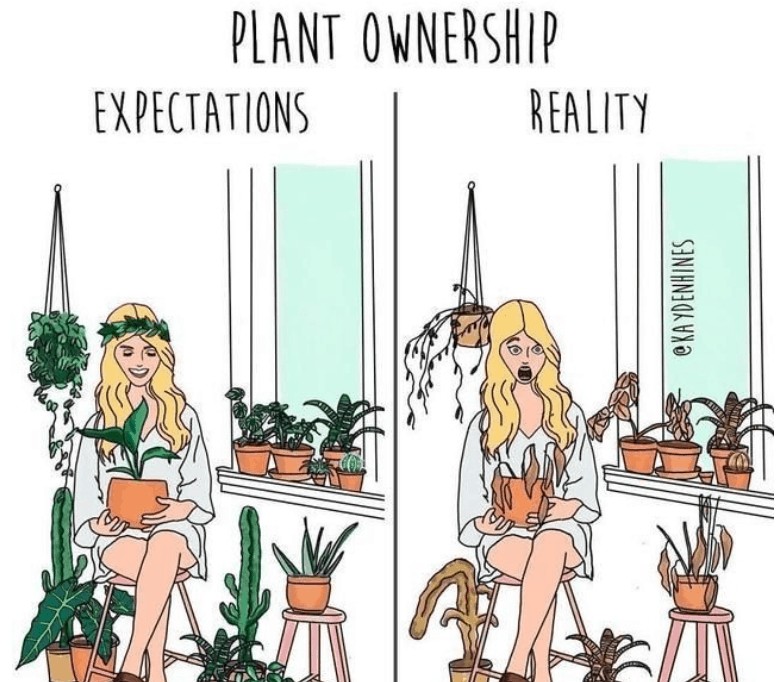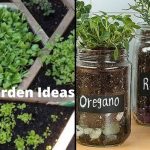Jump to:
Houseplants and indoor plants are the ultimate companions for those with a green thumb. But everything from levels of light to keeping soil moist and selecting the right plant pot can affect your plant’s survival.
So if you want to keep house plants alive or they keep dying, following this guide to find out why! Who knew that too much water, sunlight, and even fun could be killing your plants?
But it might not all be your fault:

“For those who are new to house plants, there are a few habits that should be ditched immediately.”
8 things to avoid when caring for house plants
1. Choosing the wrong indoor plants
If you want to go out and get yourself a plant friend, then you need to ensure you have the ideal conditions to help it grow. Not all indoor houseplants thrive in all houses!
When you’re in the plant shop – just ask! If you want to be successful plant parents, do some research into what plants would work best in your home. Think about where you can put them and how much sunlight they’ll get.
You might want to fill your house with every plant possible but you have to be smart. For example, some plants might not thrive in your climate (even indoors). Some houseplants might do well in sunny areas and others in shade. What natural environment can you offer?
2. Houseplant overwatering and lack of water
Plants need water, right? So a lack of water can’t be good for them. But who knew that excess water could also be bad?
House plants need constant and regular water. But, of course, this will vary from plant to plant. That’s why doing your research in step one will help.
But overwatering is also a common cause of death in houseplants. So if your plant’s:
- Leaves are turning yellow
- Soil is moist
- Base shows fungus growth
Then, chances are, you’re overwatering it. As a rule of thumb, you want to keep compost moist (not wet and not bone dry!). Still, knowing your plant will help as plants like orchids, succulents and cacti all have different needs from one another.

3. Pots, Potting Soil, and Drainage
Where you put your houseplant is also important to its survival. And drainage is important. You want to put house plants in pots with holes for water to drain out into a tray.
If your pot doesn’t have drainage holes and/or a try you can effectively drown your plants! Just like in the last step, if leaves have become wilted and droopy or you constantly have damp soil it’s probably over-watered. It’s not good for plants to be sitting in water.
But what if it’s just holding water?
If your house plant doesn’t have enough space to grow, it can get root-bound or get root rot and need re-potting. Otherwise, it’ll become top-heavy and wither and die.
Remember, just because you got in in a pot doesn’t mean that it wants to live in that pot forever!
So if you need to re-pot a houseplant to something with adequate drainage, you’ll need potting soil. With extra nutrients and fertilizers (rather than just garden dirt!) you can ensure your plant stays strong. You can also line the pot with pebbles to raise roots and ensure drainage.
You can even find specific potting mixes for certain houseplants.

4. Watering all your plants on the same schedule
Now we know that watering too much can drown a plant. So what do you do when you have lots of different houseplants?
Well, you’ll want to have a watering schedule but you shouldn’t water them all according to the same schedule. Instead, you’d be better to feel the soil of each plant rather than set anything in stone.
If leaves are turning brown and you notice brown spots and dead leaves – water it more. If soil is wet and leaves are dropping, you might be overwatering it.
When giving your plant a drink, do so until water runs out the drainage holes or the soil becomes saturated. If water begins to pool on top of the soil, stop watering immediately.
And remember, plants like room temperature water not an ice bath!
5. Purchasing with no labels
If you’re a gardening novice, plant labels are super useful. They give you:
- Plant name
- Care instructions
- Hardiness and soil information
- Ideal environment temperatures
Now, every plant needs water, light, air, and soil (except air plants), right? But how much of each of these they need varies from species to species. Does your plant want direct or indirect light? Start by taking your plant label and googling the Latin name + care tips.
Then again, blindly following labels (and even guides!) can get you in trouble. Remember, you need to be the one who knows best. Check your house plant’s soil and keep an eye on their leaves. Water and move them accordingly!
6. Putting plants near a radiator
Short and sweet this one – if you put your houseplant plant near a radiator, it’s going to die. Relentless heat and a lack of air moisture will cause it to wilt, dry out, and even die. No amount of watering will save it so keep plants away from radiators!
7. Direct sunlight and heating
This one might shock you but most house plants don’t like direct sunlight. A good indicator of this is if your plants are wilting and even dying despite adequate watering. If so, try rotating them out of the sun.
Remember, different house plants will need different light levels and even light conditions. Drooping or pale foliage is a sure sign of not enough light.
Try to choose places with indirect sunlight like north-facing windows, a windowsill, cart or even planter shelves. This will also help keep plants out of the way of pets.
Just look at snake plants and ZZ plants, for example. They do well in low light environments.

8. Giving up after your first death
If your first plant dies, don’t beat yourself up. It might not even be your fault. Ok, not just your fault!
Your home might not have ideal lighting conditions. Or, the plant you bought might have already been dying or root-bound. If this guide teaches you anything, it’s that you need to get a feel for your plants and be attentive.
Just keep at it!

Tips To Keep Houseplants Alive
Plant Care and Indirect Light
To keep your plant alive and healthy:
- Give it natural light instead of bright light (Indirect is best, pick a sunny spot on a windowsill).
- A rule of thumb – Literally, use your thumb to test the soil. Keep it moist but not wet or bone dry!
- Give your houseplant a pot that’s big enough and has adequate drainage.
- Remember that: spider plants, snake plants, tropical plants, Peace Lillies, African violets, desert plants etc. all need different conditions!
- Ask for help – Check online, ask at your local plant shop, check labels and follow this guide!
And if you’re eyeing up a greenhouse to keep your plants in, check out our range via the button below!
Shop GreenhousesWhat are the best indoor house plants?
Peace Lillies, ZZ plant, snake plants, and any potted succulents make great indoor house plants.
How often should you water house plants?
- First, make sure it's in a big enough pot with drainage
- Water it with warm water and build a watering schedule
- Regularly check soil and drainage by feeling the soil to protect against improper watering
- Reduce regularity if you see fungus growths or leaves turning yellow
How to get rid of flies in house plants?
Spray the top layer of houseplant soil with a diluted solution of soapy water or use a natural pesticide.
How to look after house plants?
Make sure to read your house plant's label and do some research. Giving it the correct lighting condition and watering schedule will help it thrive. If you notice brown spots and dead leaves, try rotating it out of the sun and watering it more regularly.










